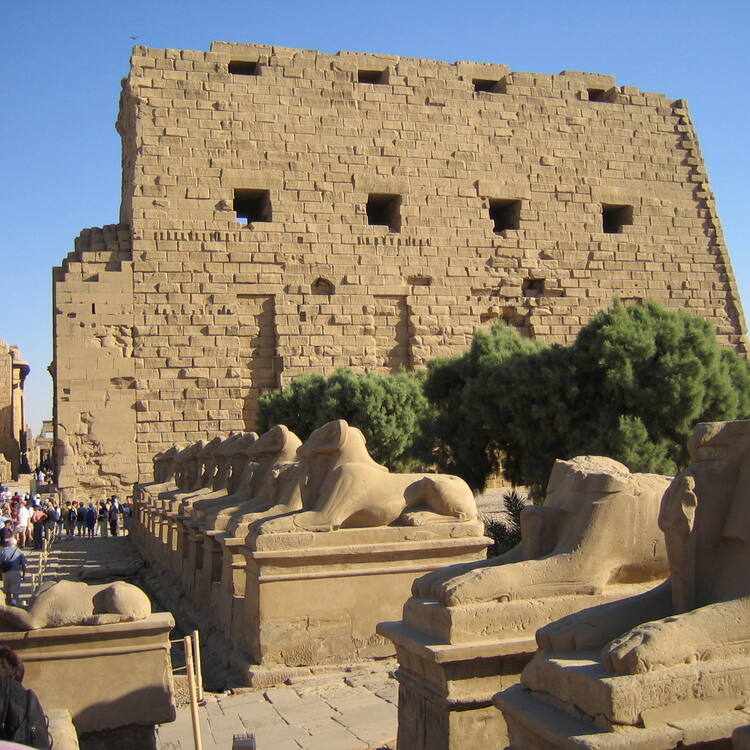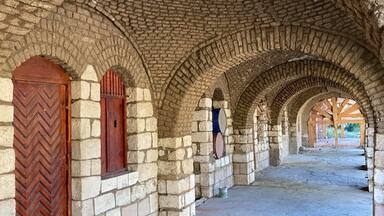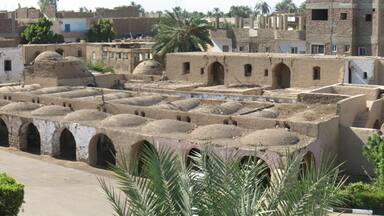Ancient Thebes with its Necropolis
Ancient Thebes with its Necropolis
Thebes, the city of the god Amon, was the capital of Egypt during the period of the Middle and New Kingdoms. With the temples and palaces at Karnak and Luxor, and the necropolises of the Valley of the Kings and the Valley of the Queens, Thebes is a striking testimony to Egyptian civilization at its height.
Description is available under license CC-BY-SA IGO 3.0
Thèbes antique et sa nécropole
Capitale de l'Égypte au Moyen et au Nouvel Empire, Thèbes était la ville du dieu Amon. Avec les temples et les palais de Karnak et de Louxor, avec les nécropoles de la Vallée des Rois et de la Vallée des Reines, elle nous livre des témoignages saisissants de la civilisation égyptienne à son apogée.
Description is available under license CC-BY-SA IGO 3.0
مدينة طيبة القديمة ومقبرتها
طيبة هي عاصمة مصر في عصري الأمربوطوريتين الوسطى والجديدة و مدينة الإله أمون. شاهدة على الحضارة المصريّة يوم بلغت ذروتها بما فيها من معابد وقصور الكرنك والاقصر ومقابر وادي الملوك ووادي الملكات.
source: UNESCO/CPE
Description is available under license CC-BY-SA IGO 3.0
底比斯古城及其墓地
底比斯(Thebes)是古埃及中新王国时代的首都,是阿蒙神(god Amon)之城,与卡纳克(Karnak)和卢克索(Luxor)的神庙和宫殿、国王陵墓谷和王后陵墓谷一起,共同构成了埃及文明繁荣鼎盛的见证。
source: UNESCO/CPE
Description is available under license CC-BY-SA IGO 3.0
Древние Фивы с их некрополями
Фивы, город бога Амона, были столицей Египта в период Среднего и Нового Царств. Храмы и дворцы Карнака и Луксора, а также некрополи Долины Царей и Долины Цариц, представляют собой яркие свидетельства египетской цивилизации времен ее наибольшего расцвета.
source: UNESCO/CPE
Description is available under license CC-BY-SA IGO 3.0
Antigua Tebas y su necrópolis
Tebas, la ciudad del dios Amón, fue la capital de Egipto en tiempos de los imperios Medio y Nuevo. El sitio comprende los templos y palacios de Karnak y Luxor, así como las necrópolis del Valle de los Reyes y el Valle de las Reinas. Todos estos monumentos son testimonios impresionantes del apogeo de la civilización egipcia.
source: UNESCO/CPE
Description is available under license CC-BY-SA IGO 3.0
古代都市テーベとその墓地遺跡
source: NFUAJ
Oude stad Thebe met haar necropolis
Source: unesco.nl
Outstanding Universal Value
Brief synthesis
Ancient Thebes was the city of the God Amun, and it was the capital of Egypt during the period of the Middle and New Kingdoms. It lies about 700 km south of Cairo on the banks of the River Nile. With the temples and palaces at Karnak and Luxor, and the necropolises of the Valley of the Kings and the Valley of the Queens, Thebes is a striking testimony to Egyptian civilization at its height, when the city became the capital of an empire extending from the Euphrates to northern Sudan.
The three-part serial property consists of the two temples of Karnak and Luxor on the East bank of the Nile, and a large archaeological area on the West Bank consisting of seven named temples or complexes, covering an area of 7,390 ha with a buffer zone of 444 ha.
Ancient Thebes was one of the richest and most important cities in ancient Egypt. Throughout most periods of ancient Egyptian history, Thebes functioned as the religious capital of the country. In certain periods, such as the Second Intermediate Period (c. 1650-1550 BCE), following the invasion of the Hyksos (a western Asian people), and their taking over the north of Egypt, establishing their capital in the eastern Delta city known as Avaris, local Egyptian dynasties (Dynasties 16 and 17) ruled from Thebes.
The remains of an ancient town from about 1500 to 1000 BCE was one of the most spectacular in Egypt, with a population of perhaps 50,000. Even in the Middle Kingdom, four centuries earlier, Thebes had earned a reputation as one of the ancient world’s greatest cities. Within it, the Egyptians had built the huge temple complexes of Karnak and Luxor. These are two of the largest religious structures ever constructed, and the homes of priesthoods of great wealth and power. On the West Bank lies the Theban Necropolis covering about 10 km² in which archaeologists have found thousands of tombs, scores of temples, and a multitude of houses, villages, shrines, monasteries, and workstations.
Thebes includes areas on both the east and west banks of the Nile. The east bank contains the living city as well as fourteen temples, the most famous of which are the temples of Luxor and Karnak. The west bank is known as the “City of the Dead”.
Criterion (i): Thebes, the city of the god Amun, is renowned for its temples whose imposing ruins are the glory of Karnak and Luxor. These truly colossal complexes, which have been enlarged numerous times, comprise some of the most fascinating realisations of Antiquity: the ‘Hypostyle Hall’ of Karnak begun by Seti I and completed by Ramses II (measuring 102 metres in width and 53 metres in depth, covers a surface area of 5,000 square metres; its roof is supported by 134 columns, those of the central nave measuring 20.4 metres with a diameter of 3.4 metres); the temple of Amenophis III at Luxor, one of the most refined masterpieces of Egyptian architecture (14th century BCE). The Theban necropolis relinquishes nothing in importance or beauty to these monuments: it suffices to note the tombs of the Valley of the Kings (1500 – 1000 BCE), among which is that of Tutankhamun, those of the Valley of the Queens, where, among others Nephertari, wife of Ramses II, and her mother Tui are entombed; and finally at Deir El Bahari (Thebes west) the funerary temple of Queen Hatshepsut with its immense porticos, its superimposed terraces flanking the mountain, and its frescoes which trace her journey to the country of Punt.
Criterion (iii): The few examples which remain among these splendid monuments serve to attest to the antiquity, the uniqueness and unequalled character of the monumental Theban ensembles.
Criterion (vi): The monumental and archaeological complex of Thebes with its temples, tombs, and royal palaces; its villages of artisans and artists; its inscriptions; its innumerable figurative representations, as valuable from an aesthetic as from a documentary point of view, constitute the material witness of the aggregate history of the Egyptian civilization from the Middle Kingdom to the beginning of the Christian era. Moreover, the texts and the paintings are the source of information concerning the people and cultures of neighbouring countries: Nubia, the country of Punt, Libya, as well as Syria and the Hittite and Aegean civilisations.
Integrity
Ancient Thebes with its Necropolis contains within its boundaries sufficient of the key attributes that convey the property’s Outstanding Universal Value, as an ensemble of unique splendour in excellent condition. The perfection of ancient building techniques ensured the resistance of the monuments to natural forces through time. Despite the unavoidable damage of time, they still display their beauty and convey their inestimable artistic and historic value, preserving all the features that directly and tangibly associate them with the events and ideas of religious and the development of methods of burial through the periods. The vicissitudes of history have caused extensive damage that is being successfully addressed with the ongoing restoration and conservation works, which increase both the stability and the legibility of the monuments, tombs and the pyramids of the property.
The property does not suffer any more of the rising of underground water levels, and it is still under pressure from the risks of flooding, tourism / visitor / recreation, major infrastructure and urban development projects, and housing and agricultural encroachment.
Authenticity
The form, design, materials and substance of the monuments of the property from the temples, tombs and settlements characterize it as one of the most authentic among the known monuments of the ancient world. The property preserved almost 80% of its ancient form and material. The interventions in some of the most significant structures have been made in accordance with the international principles of restoration with respect to the legibility of the edifices and to the principle of reversibility. The locations and setting of the monuments have been almost entirely preserved, there are no changes in the authentic character of the site during the last years, and until now there are many events and beliefs associated with the history of Egypt, so that visitors are still able to experience the spiritual character of the archaeological site.
Protection and management requirements
The extent of the property is very large with its components. Its protection is ensured by a comprehensive system of statutory control operated under the provisions of the Protection of Antiquities Law No. 117 of 1983 as amended by the Law No. 3 of 2010, and No. 91 of 2018 and No. 20 of 2020 for the protection of monuments, which also established the rules for preserving archaeological sites in Egypt, while the Law of Environment No. 4 of 1994 does so for protecting the natural landscape of the site, Urban harmony Law No. 114 of 2006 regulating the demolition of non-perishable buildings and facilities, and preserving the architectural heritage, and Building Law No. 119 of 2008, also known as the “Unified Building Law” that was released by a presidential decree and ratified by the house of parliament on the 11th of May 2008, in order to systemize and regulate the process of building in the whole Republic.
The property is owned by the State, Region and private owners. Its various elements are managed and protected by the Supreme Council of Antiquities through the Antiquities inspectorate of Luxor in coordination with Luxor Governorate and other relevant authorities as a functional and effective management system.
Separately, the Ministry of Antiquities has conducted a number of comprehensive maintenance, conservation and rehabilitation projects at each area of the property. These projects are being carried out with the involvement of all major stakeholders, as well as the local community, in the management of the site. The interventions in these projects have been made in accordance with the international principles of restoration, with respect to the legibility of the edifices and to the principle of reversibility.
Within the property of Ancient Thebes and its Necropolis there are twelve major archaeological sites, and it is a major challenge to formulate one comprehensive management plan for the overall property including conservation, future planning, visitor management and capacity development. Developing an overall effective and comprehensive management system involving all the key stakeholders nationally and locally is essential.
Currently, a comprehensive management plan for the overall property is in developmental stage, and the State Party is working on the boundary modification for the World Heritage property to include the Avenue of Sphinxes, to make sure that all attributes are contained within the boundary of the property.

 View photos from OUR PLACE the World Heritage collection
View photos from OUR PLACE the World Heritage collection


